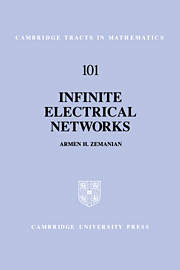3 - Finite-power Regimes: The Linear Case
Published online by Cambridge University Press: 05 February 2012
Summary
In 1971 Harley Flanders [51] opened a door by showing how a unique, finite-power, voltage-current regime could be shown to exist in an infinite resistive network whose graph need not have a regular pattern. To be sure, infinite networks had been examined at least intermittently from the earliest days of circuit theory, but those prior works were restricted to simple networks of various sorts, such as ladders and grids. For example, infinite uniform ladder networks were analyzed in [31], [73], and [139], works that appeared 70 to 80 years ago. Early examinations of uniform grids and the discrete harmonic operators they generate can be found in [35], [44], [45], [47], [52], [54], [65], [84], [126], [135], [143].
Flanders' theorem, an exposition of which starts this chapter, is restricted to locally finite networks with a finite number of sources. Another tacit assumption in his theory is that only open-circuits appear at the infinite extremities of the network. The removal of these restrictions, other extensions, and a variety of ramifications [158], [159], [163], [177] comprise the rest of this chapter. However, the assumptions that the network consists only of linear resistors and independent sources and is in a finite-power regime are maintained throughout this chapter.
Actually, finite-power theories for nonlinear networks are now available, and they apply just as well to linear networks as special cases. One is due to Dolezal [40], [41], and the other to DeMichelle and Soardi [37].
- Type
- Chapter
- Information
- Infinite Electrical Networks , pp. 61 - 107Publisher: Cambridge University PressPrint publication year: 1991

